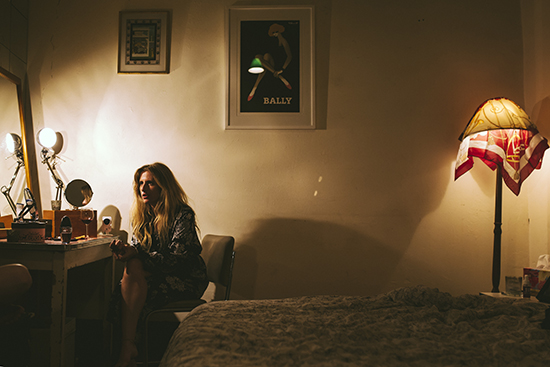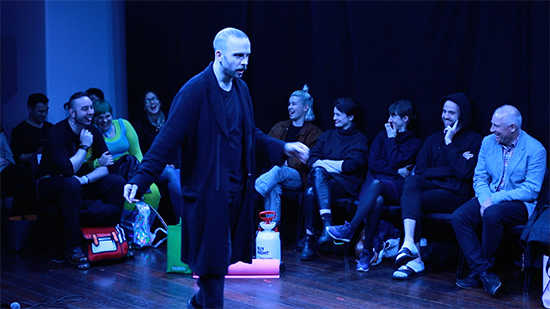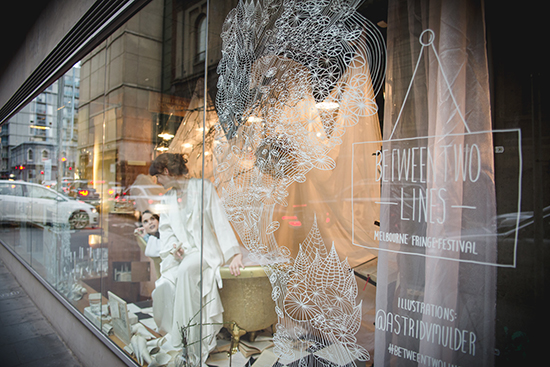Melbourne Fringe: angles on unsexed perspectives
John Bailey: ménage; Hyperspirit; Between Two Lines

Ménage
I’m wandering through a North Melbourne dusk with an envelope of cash, a phone number and a stranger. We’re off to meet a sex worker, and that’s about all we know. My companion is as clueless as I am and seems a little more trepidatious, but I can’t know that for sure. It’s an unusual experience to share with someone you’ve just met.
ménage
Ménage is a live art experience devised by the industrious UK/US performance maker Ryan Good, developed from interviews with sex workers in various countries. The work itself is startlingly brief—around 25 minutes in total—and site-specific. While the aura of secrecy that surrounds the actual content of the encounter should be preserved, it’s enough to say that the audience of two spend those minutes in conversation with a performer playing a female sex worker who is a composite of a number of women. The work doesn’t cohere to a single or continuous time-frame and the performance style is just as likely to leap into an unexpected place.
What surprised me most about this work wasn’t how much character and story manage to be packed into such a short time—an impressive volume, as it turns out. It wasn’t the particulars revealed about sex work as a career or the way they intersect with a worker’s private life, which are as mundane as most professions when examined without a moral posture. What left me most curious was how ineluctably gendered the encounter felt, in ways both provocative and troubling.
The early moments of the work present such an affable and empowered vision of sex work that I worried this was a romantic gloss about as textured as Pretty Woman. It immediately struck me that the fact that this work has been created by a man can’t be easily dismissed. Even though I came through the 90s era of education that laid waste to biological essentialism and deterministic models of gender, I can’t help but feel there is a necessary reading of ménage that takes sex into account.
Thankfully, the work does introduce greater nuance and variety of experience, also begging its witnesses to consider their own implication in the work. My positioning as one of two men, not known to each other, sharing this encounter will likely have provided a different unspooling of meaning than had we been mixed sex, or friends or related along any other set of axioms. The work’s grounding in real interviews might have afforded its maker more permission, too. But why then should I remain so unresolved about the fact that it is finally a man telling these stories?

Hyperspirit, Marcus McKenzie, Melbourne Fringe Festival
Hyperspirit
Just as unexpected was the peculiar gendering of Marcus McKenzie’s masterful Hyperspirit, a work that a sizeable number of people I spoke to described as ‘masculine.’ It’s not that the work deals with masculinity per se, but that in so many ways it seems aligned with a range of particular aesthetic traditions that have been dominated by masculine voices. McKenzie plays the Hyperspiritualist, a riff on the familiar televisual spirit medium whose channelling of the afterlife is via a stream of constant talk. McKenzie doesn’t adhere to the performative style of John Edwards, however, instead adopting a delivery much closer to slam poetry and beat performance, spitting his unbroken rant and never missing an opportunity to rhyme or alliterate. The work is also firmly camped in the allusive maximalism of the postmodern author, sewing together genres including noir, the Gothic, Greek myth (Aristophanes’ The Frogs appears as a significant intertext) and fable. As much as his role communicates with the spirits of the dead, McKenzie here seems possessed by Ginsberg and Kerouac, the TV mentalists who cold-read https://en.wikipedia.org/wiki/Cold_reading mourners and a pantheon of dark and declarative authors running from William Blake to Cormac McCarthy.
The work is a serious achievement and its performance is at times virtuosic. It’s the kind of technical wonderment that often left me cold, but in a way that’s inarguably about my taste rather than its maker’s ability. McKenzie demands attention, here and in the future.

Between Two Lines, Anna Naipantidis, Melbourne Fringe Festival
Between Two Lines
There’s no shortage of authors behind Anna Nalpantidis’ Between Two Lines. This live art experiment in ‘bibliotherapy’ deploys the words of great writers to attempt to soothe the soul of its sole audience member. Situated in the window of an operating bookshop, the attendee is dressed in a white bathrobe, settled into a tub full of soft materials and guided through a series of intimate moments appealing to each of the senses. Passages from enduring written works are whispered, but are also part of the materials from which the installation is constructed.
The work is clearly in ASMR territory, aiming for the tingling ‘auto-sensory meridian response’ some say they experience when given particular sense triggers. ASMR videos are all over YouTube, where softly-spoken women (there are almost no male ASMR-tists) guide viewers through gentle, nurturing sequences of hair-brushing or paper rustling or other unassuming actions. There’s often something parental about the level of close attention and calming behaviour featured in these videos, and it’s something Nalpantidis reproduces well through the rich environment she has created.
It all unfolds in public, too, which adds an extra frisson. I was hearing the words of Carl Sagan murmured to me while passersby dropped their jaws or began giggling at the man in the bath sipping tea in a bookshop window. Some people came back for a second look.
While I still don’t subscribe to any biological essentialism, these three works did suggest that the conceit of an unsexed perspective is often one dependent on a certain privilege. Hyperspirit may not deliberately make a statement about gender but it exists within a space conventionally defined by a masculine voice that denies its own genderedness; ménage, conversely, offers an uneasy slippage between the sexed bodies of its subjects, performers and audience and the absent body of its maker. The relationships conjured by Between Two Lines seem more evocative of those between parent and child, and are just as dense with the audience member’s own history and corporeality. All are generous reminders that there’s no performance without at least one meatbag to watch it.
–
Melbourne Fringe: Lucy Tafler Presents, ménage, devisor Ryan Good, performers Claire Maria Fox, Jessica Stanley, secret location, North Melbourne, 16 Sept-1 Oct; Hyperspirit, creator, producer Marcus McKenzie, performers Marcus McKenzie, Maria Moles, Ryan Forbes, Arts House, 24 Sept-1 Oct; Between Two Lines, by Anna Nalpantidis, performer Elizabeth Brennan, Embiggen Books, Melbourne, 17 Sept-1 Oct
RealTime issue #135 Oct-Nov 2016






